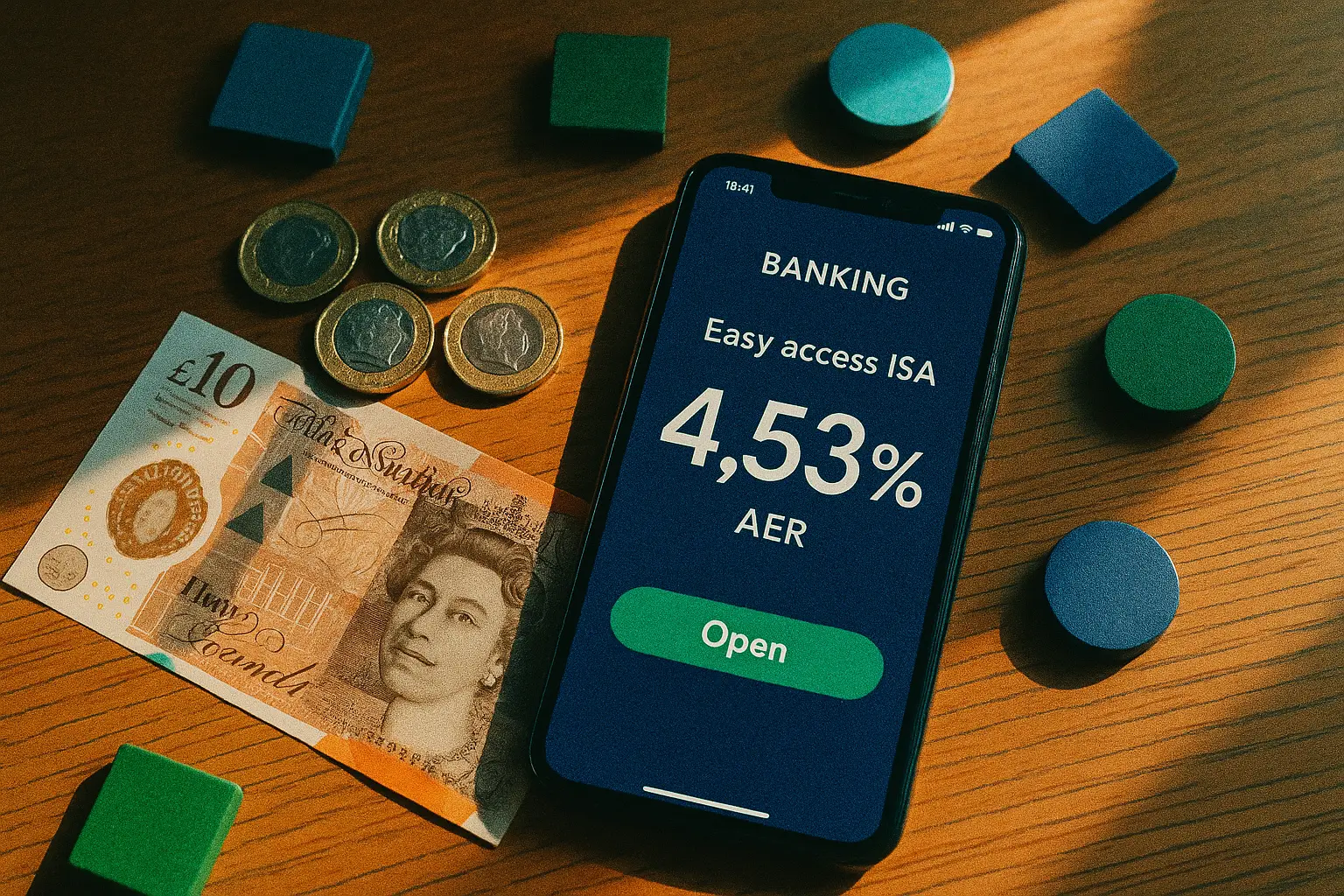What is an easy access ISA?
An easy access ISA is a flexible savings account that allows you to deposit and withdraw money without restrictions, while earning tax-free interest. It is ideal for beginners looking for liquidity alongside growth.
Key features and benefits
Easy access ISAs offer unlimited withdrawals at any time, making them suitable for emergency funds or short-term savings. Interest is calculated daily and paid annually, with rates quoted as AER (Annual Equivalent Rate), which shows the true return including compounding. Over 11 million people in the UK held Cash ISAs in 2024, with easy access options accounting for 60% of new openings due to their flexibility, according to MoneySavingExpert.com.
Differences from fixed-rate ISAs
Unlike fixed-rate ISAs, which lock your money for a set period in exchange for higher, guaranteed interest, easy access ISAs have variable rates that can fluctuate with the market. Fixed-rate options suit those who can commit funds long-term, while easy access provides freedom but potentially lower returns. For more on ISA types, see our ISA options.
Tax advantages in 2025
Interest earned in an easy access ISA is tax-free, shielding your savings from income tax or capital gains tax. The tax year runs from 6 April 2025 to 5 April 2026, aligning with HMRC rules. This makes it a smart choice for UK residents seeking to maximise returns without tax deductions.
Eligibility requirements
To open an easy access ISA, you must meet basic criteria set by HMRC, ensuring only qualified individuals benefit from tax relief.
Age and residency rules
You need to be at least 18 years old and a UK resident for tax purposes to qualify for easy access ISA eligibility in the UK. Non-residents or those under 18 cannot open new ISAs, though existing ones may be maintained under specific conditions. Joint accounts are not permitted for Cash ISAs, per GOV.UK guidelines.
Annual allowance limits
The ISA allowance for 2025 is £20,000, covering all ISA types combined for the tax year. You can contribute up to this amount in one go or spread it out, but exceeding it means the excess is not tax-free. Transfers from previous ISAs count towards this limit but do not use new allowance.
Income source restrictions
Funds must come from your own money, such as earnings, savings, or gifts, but not from joint sources in a way that violates HMRC rules. For detailed eligibility, visit the official GOV.UK ISA opening guide.
Tip: Double-check your residency status if you’ve recently moved, as it affects tax residency and ISA eligibility.
Step-by-step process to open an easy access ISA
Opening an easy access ISA online is straightforward and often takes just minutes, allowing you to start saving tax-free quickly.
Choose a provider and compare rates
Research providers using comparison sites to find competitive rates; the top easy access ISA rates in the UK reach up to 4.53% AER as of November 2025, per Moneyfactscompare.co.uk. Consider minimum deposits, typically £500, and FSCS protection up to £85,000. For current options, explore easy access ISA comparisons or our guide on best easy access isa.
Gather required documents
Prepare your National Insurance number, proof of identity (like a passport), proof of address (utility bill), and bank details for funding. Digital scans work for online applications. This ensures compliance with anti-money laundering rules.
Apply online or in-branch
Most providers allow you to open an easy access ISA online via their website or app—select the product, fill in personal details, and declare your tax status. In-branch options suit those preferring face-to-face help, available at banks like Santander. The process mirrors standard banking sign-ups but includes an ISA declaration form.
Fund your account
Transfer money from your current account or another ISA; initial deposits can be as low as £1 for some providers. Use the faster payments service for instant crediting. Remember, contributions reset on 6 April each tax year.
Monitor and manage
Once open, track your balance and interest via the provider’s app or statements. Rates are variable, so review periodically. For beginner insights, read our article on what is an easy access isa.
| Provider | AER Rate | Min Deposit | Withdrawal Terms |
|---|---|---|---|
| Chip | 4.53% | £1 | Unlimited |
| Plum | 4.50% | £100 | Unlimited |
| Shawbrook Bank | 4.49% | £1,000 | Unlimited |
| Santander | 4.20% | £500 | Unlimited |
| First Direct | 4.10% | £1 | Unlimited |
Note: Rates variable and subject to change; data from Moneyfactscompare.co.uk, November 2025.
Choosing the best provider for 2025
Select a provider based on your needs for accessibility and returns, focusing on reputation and features.
Top rates and minimum deposits
Higher AER rates boost tax-free growth, but check for introductory offers that drop after. Minimum deposits vary from £1 to £1,000; choose low-entry if starting small. See MoneySavingExpert’s cash ISA guide for updates on easy access ISA rates.
Transferring existing ISAs
To transfer an easy access ISA, contact your new provider—they handle the process without using your current year’s allowance. It takes 5-15 working days, and interest continues accruing. No tax implications apply, but confirm with HMRC if multiple transfers.
Common pitfalls to avoid
Avoid exceeding the £20,000 allowance across all ISAs, and don’t forget variable rates can fall. Always verify FSCS coverage for safety. For latest rates, check our easy access isa rates update.
Frequently asked questions
What is an easy access ISA?
An easy access ISA is a type of Cash ISA that lets you withdraw money anytime without penalties, earning variable tax-free interest. It’s popular for its flexibility, with over 11 million UK holders choosing Cash ISAs for everyday savings. Unlike stocks, it’s low-risk, protected by FSCS up to £85,000 per provider.
How much can I put in an ISA in 2025?
The annual ISA allowance for 2025/2026 is £20,000, applicable from 6 April 2025 to 5 April 2026, as per GOV.UK. This covers all ISAs, so split wisely between cash, stocks, or lifetime types. Unused allowance doesn’t roll over, so plan contributions early for maximum tax-free benefits.
Can I open multiple ISAs?
Yes, you can open multiple ISAs of the same type in a tax year, but the total across all cannot exceed £20,000. For example, one easy access and one fixed-rate Cash ISA are allowed, provided the combined limit isn’t breached. This strategy diversifies returns while staying tax-efficient.
What’s the difference between easy access and fixed rate ISAs?
Easy access ISAs offer flexibility with unlimited withdrawals but variable rates around 4-4.5% AER, ideal for accessible funds. Fixed-rate ISAs guarantee higher rates (up to 4.28%) for a term but penalise early access, suiting committed savers. Choose based on liquidity needs versus potential yield.
How do I transfer an existing ISA?
Contact your new provider to initiate a transfer; they’ll move funds from your old ISA without tax charges. The process preserves interest and doesn’t count against your new allowance if done within rules. It typically completes in two weeks, minimising downtime.
What documents do I need to open an easy access ISA?
You’ll need ID like a passport or driving licence, proof of address such as a recent bill, and your National Insurance number. Bank statements verify funding sources. Online applications accept digital uploads, speeding up approval from providers like First Direct.
Is an easy access ISA safe?
Yes, easy access ISAs from UK-authorised providers are protected by the FSCS up to £85,000 if the institution fails. Interest is tax-free, reducing overall risk compared to taxable accounts. Always confirm the provider’s FCA regulation for peace of mind.
How long does it take to open an easy access ISA online?
Most online applications process in minutes, with account activation same-day if documents are ready. Funding via bank transfer clears instantly, allowing immediate interest accrual. In-branch openings may take longer due to verification, up to a few days.







